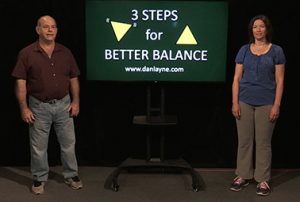 |
 |
 |
BALANCE VIDEOS
The videos are not intended to be an online course but rather a supplement for students who are enrolled in one or more of my courses.
Falling is life threatening. The videos cannot substitute for in depth balance training or clinical physical therapy. There are many aspects of balance training that require special equipment and can only be safely administered in person.
The videos and articles can serve as a basic introduction to balance training. Active participation with the videos may help lower the risk of falling and improve quality of life.
Please Read The Guidelines for Safe Practice:
Suggested Viewing Options for Practice Videos:
- Very low exertion (~14 min): Seated 1
- Low exertion (~30 min): Seated 1, Seated 2
- Low – moderate exertion (~45 min): Seated 1, Standing 1, Seated 2,
- Moderate exertion (~55 min): Seated 1, Standing 1, Seated 2, Standing 2
- More Challenging (~55 min): Seated 1, Standing 1, Standing 2, Seated 2
- Alternate Standing Balance Sequence (~20 min ): Tai Chi Chuan Sequence #1
Balance Sequence #1: Seated Exercises – Part 1 – Beginning (13:42)
This video is the first in a series. It establishes a foundation for safe movement by laying out a pathway, structure, and approach to balance training that will strengthen the basic elements of balance control and movement. The primary objective is to lower the risk of falling. All of the exercises are performed in a seated position, making this sequence low risk.
The sequence should be repeated frequently, regardless of the level of the participant.
The movements may be especially useful to a person who is experiencing some anxiety about falling and needs a measured start in order to be able to heed the inner call to action. For a person who has been inactive for a period of time, this video can serve as a point of entry toward restoring movement and the independence that goes with it.
A broad goal is to repeat a lesson or lessons in order to establish a sustainable pattern – like once or twice a week for two months – take a couple of weeks off – then do it all over again. I have observed over the years that a consistent pattern seems to have a stronger effect, such as same day and approximate time.
Every little bit helps. Do what you can, don’t over do it, and have faith that little by little the benefits will begin to accumulate.
Balance Sequence #2: Seated Exercises – Part 2 – (16:44)
This video emphasizes hip and leg strength, flexibility, and core strength that is essential for controlling posture.
Balance Sequence #3: Standing Exercises – Part 1 – (15:39)
This video is part one of the standing balance exercises. It begins with some tips for improving the transition from sitting to standing. The emphasis in this session is on posture, weight shifting, and control over the hip as a primary balance control when standing.
Balance Sequence #4: Standing Exercises – Part 2 – (9:56)
This video introduces basic stepping patterns that improve strength, control, agility, and compensation for balance loss.
Focus on Hip & Leg Strength (19:56)
The most common reason for impaired balance is the loss of strength in the hip and legs. If you are having trouble getting up out of chairs or experiencing other signs of weakness in the legs such as poor balance, this simple but effective sequence may help. This video focuses specifically on increasing hip and leg strength by employing four very effective exercises.
Tai Chi Chuan – Sequence #1 – Warm-up – (~20 min)
This beginning Tai Chi Chuan segment is included with the balance videos because it overlaps quite a bit with the first standing balance sequence while at the same time offering a different perspective on the movements. The same Guidelines for Safe Practice should be observed as in all of the other standing balance sequences.
Tai Chi Chuan – Sequence #2 – Basic Stepping (~12 min)
Stepping patterns are a natural extension of the weight shifting exercises that we developed in sequence #1. The combination of sequences #1 and #2 establishes a foundation of stability, balance and movement control on which we can build our tai chi chuan practice.

